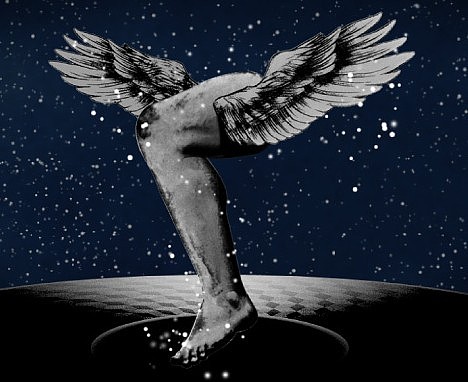
Maywa Denki, a Tokyo-based group of artists/musicians/engineers famous for inventing "nonsense machines," has teamed up with Kamakura-based IT solutions provider Kayac to develop a device that lets users visualize, monitor and control how they shake their restless legs.
The sleek black diamond-shaped contraption -- called "Yurex" (yure means "shake" in Japanese) -- straps to the thigh. A pair of silver disco ball-shaped sensors measure the leg's horizontal and vertical vibrations, and a 10-digit LCD counter displays the user's accumulated leg-shake tally.
When Yurex is connected to a computer's USB port, special software automatically downloads the data from the device and analyzes the user's leg-shaking habits and rhythm patterns. The software can also generate a personalized "creative beat pattern" based on leg-shake data obtained while the user is in a state of deep concentration. Then, whenever a boost of creative energy is needed, users can simply jiggle their knees in concert with this beat data to achieve higher brain power.

Yurex is the result of the so-called BBU Project, a collaboration between Maywa Denki and Kayac aimed at developing a marketable product that harnesses the energy of binbo-yusuri, or the constant and rapid up-and-down movement of restless legs often done unconsciously and/or out of habit.
Restless legs are highly frowned upon in Japan -- much more so than in other countries -- and the Japanese word binbo-yusuri, which literally translates as "poverty shake," has a very negative ring to it. Incidentally, there are several possible origins for the word. Some suggest it may derive from the fact that a person with a twitchy leg looks like a poor person shivering in the cold. Others link the word's origins to the tendency of loan sharks to tap their feet impatiently when collecting debts from the poor. Also, in Edo-period Japan, it is said that twitchy legs were a telltale sign that one was being stalked by Binbogami, the god of poverty.
Regardless of the word's origins, people tend to have a very negative view of binbo-yusuri, and it is often seen as a sign of poor intelligence and social grace.
The developers of Yurex, however, take a different view. They see binbo-yusuri as a sign of concentration and creativity -- a reflection of the brain at work. Moreover, they believe this "creative beat" can work in reverse. Shaking your leg in the proper way can increase concentration and creativity, they believe. Yurex is thus designed to work as a barometer of mental activity and as a tool to enhance brain power.

Yurex users are also eligible to participate in a social networking community (yurex.jp), whose members are referred to as "yusletes" (binbo-yusuri athletes). Users can display their binbo-yusuri data on the site and update it automatically each time the Yurex is connected to the computer. In addition to seeing how their binbo-yusuri counts rank in comparison to others, members can find the locations of other active "yusletes" through the site.
Yurex can also be used as a standalone device. With a 10-digit display that can tally up to 10 billion shakes, Yurex is suitable for use as a lifetime leg-shake monitor. For reference, a heavy shaker (like Maywa Denki president Nobumichi Tosa) who jiggles his leg an average of 400 times per minute for 8 hours per day will tally up nearly 5 billion shakes over a 70-year period.
Kayac plans to begin accepting orders for Yurex in January. The initial shipment, scheduled to hit shelves next spring, will be limited to 3,000 units. The price has yet to be announced.
[Link: Yurex]

No Comments
Trackbacks/Pingbacks